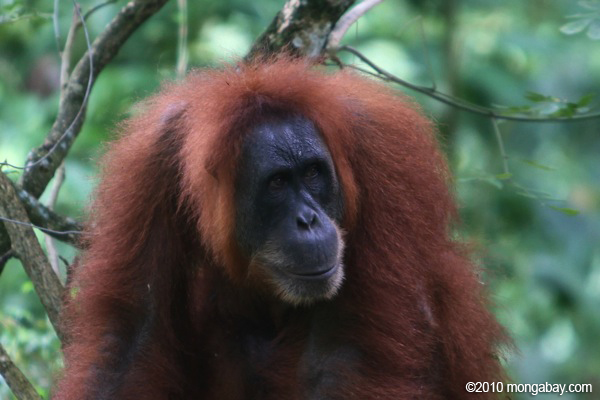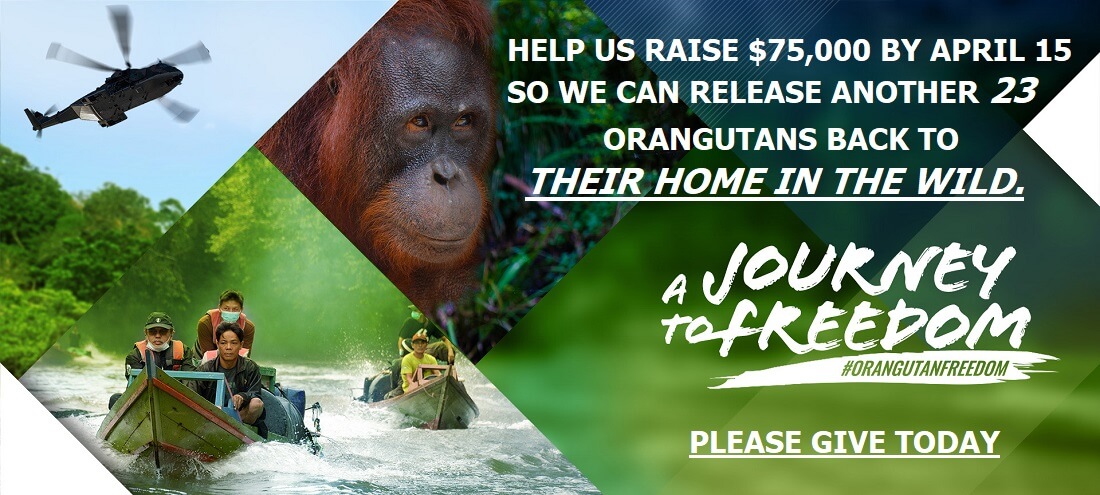Scientists propose a new way forward on orangutan conservation
Mongabay: Cynthia Malone: July 16, 2012

Orangutan in Sumatra. Photo by Rhett A Butler
Orangutans are in dire need of a revised conservation approach, according to a new study in the Annals of the New York Academy of Sciences. While the plight of the species is widely recognized within the conservation community—receiving international attention in the form of scientific research, funding, and NGO efforts—the authors argue that “there has been frustratingly little progress.”
Scientists predict the loss of most wild orangutan populations by 2025. This is not surprising when one considers that pervasive threats have led to a population decline of over 5,250 orangutans every year. Although efforts have been made to protect forests, the authors suggest that other threats have been ignored.
For wealthier countries, orangutans have become a symbol for deforestation in Indonesia and Malaysia, with palm oil as the “major culprit in the orangutans’ decline,” according to the paper. Oil palm plantations destroy forests on which orangutans depend; the study estimated that 5% of the orangutan’s range has been converted for oil palm in the last ten years alone. The recent controversy of the destruction of orangutan habitat in the Tripa peat swamp forest of Sumatra demonstrates that even government efforts to prevent forest conversion to oil palm are often ignored. However, the study argues that even though palm oil continues to pose a serious threat to orangutan survival, it is dangerous to focus efforts on a single disruptive practice. Hunting, long ignored within the conservation community, also severely threatens orangutans. Recent research has shown that current reported hunting rates greatly exceed orangutan reproductive rates, which are extremely low compared to most mammals. For example, between 700 to 3,500 orangutans are killed annually in Kalimantan, Indonesian Borneo according to scientists.
Given that conservation resources are limited, understanding how orangutans respond to threats is crucial to the survival of the species alongside an expanding human population.
“[Saving orangutans] will require that we stop seeing conservation in black and white terms of unprotected and protected or natural and unnatural,” the authors write.
Currently, orangutan conservationists often channel resources to establish new protected areas based on the premise that orangutans cannot cope with habitat disturbance. The review provides evidence to the contrary, however, highlighting research on orangutan populations surviving in previously logged forests and monoculture plantations. According to the authors, this demonstrates the “considerable ecological flexibility” of the species.
Since 75% of orangutans exist in unprotected areas, which could be logged or converted at anytime, this tolerance for disturbance is cause for hope in a time when securing additional protected habitat is unlikely. Instead of vying for protected habitat, the scientists recommend that research and resources be directed towards supporting multi-functional landscapes that provide “viable habitat for orangutans as well as people.” With greater knowledge of how orangutans respond to disturbance, comprehensive management could be instituted in unprotected areas, simultaneously accommodating the interests of local communities, agriculture, and development projects.
“I want to look at people, land-use, economic value, the role of business in conservation, any of the things that can make a change,” lead author Erik Meijaard told mongabay.com. After all, the underlying causes of habitat loss and hunting are human-derived: inefficient land use planning and forest management by Indonesian and Malaysian governments allows the destruction and degradation of orangutan areas. Inadequate law enforcement also allows orangutan-killing to largely go unpunished.
With over 20 years of conservation experience in Indonesia, Meijaard says that the conservation community needs to develop an inter-disciplinary approach that would define new goals, such as maintaining sustainable multi-functional landscapes. This would be a break from the traditional focus on ecological and behavioral research of orangutans that treats conservation as a “serendipitous afterthought” rather than a primary objective according to the paper. While the efforts of orangutan scientists and NGOs could improve, the authors emphasize that the responsibility for the persistence of orangutans in the wild ultimately lies with the Indonesian and Malaysian governments.
“Abating the threat to orangutan survival is a political choice requiring societal approval and cooperation for comprehensive solutions that involve strict protection of key habitats, effective law enforcement against harmful illegal activities, and selection of compatible land-use practices,” the authors write.
In addition, the paper argues that there is a dire need for more involvement from Indonesian and Malaysian scientists, as an earlier study reported they authored only 1% of publications including the keywords “orangutan/orang-utan” and “conservation.” Indigenous researchers could potentially play a great role in enabling societal change on the ground and harnessing political recognition of conservation.
“Losing a great ape from the wild would be a landmark failure,” the authors assert. Beyond the importance of orangutans as our close genetic relatives, the species have important ecological roles as seed dispersers and ecosystem engineers. Destruction of orangutan habitat also results in the destruction of habitat for countless species that share the same forests, including many that are also native only to Indonesia and Malaysia. Furthermore, people who reside in or near forests depend on its natural resources for their livelihoods.
As with efforts to protect any species, the authors assert that orangutan conservation requires not just research, but creative, cross-disciplinary thinking that considers ecosystems and all stakeholders. The dedication of conservationists has led to some successes—such as acquiring legal protection for key orangutan habitat—but if the species is to persist in the wild a paradigm shift is needed.
CITATION: Meijaard, E., Wich, S., Ancrenaz, M. and Marshall, A. J. (2012), Not by science alone: why orangutan conservationists must think outside the box. Annals of the New York Academy of Sciences, 1249: 29–44.
Cynthia Malone is a Zoology and Anthropology undergraduate researching the oil palm industry in Indonesia as a summer research fellow at the Center for Sustainability and the Global Environment (SAGE) at the University of Wisconsin-Madison.





